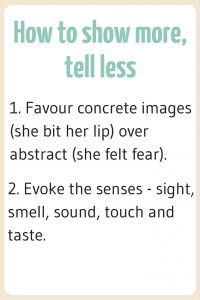Common novel writing tips should never be applied without further thought. Here are 7 common writing tips you'll hear in creative writing classes and writing groups that you should avoid applying blindly:
1. 'Write what you know'
It's true that to write a great story, you need closeness to your material. Don't take novel writing tips like this completely literally, though. Contemporary British historical fiction author Philippa Gregory couldn't personally know the 16th-Century aristocrat Mary Boleyn. That didn't stop her historical novel The Other Boleyn Girl (2001) from getting critical acclaim and a film adaptation.
Take 'write what you know' figuratively: Write about experiences and events you know in the sense that you can relate to them. If you can relate to your material, this emotional and/or intellectual closeness will filter into your work and affect readers.
Be daring, also - becoming a skilled writer means honing your ability to write convincingly about what you don't know; the things you can't personally empathise with but can at least imagine.
2. 'Show, don't tell'

'Show, don't tell' is good advice in some respects. What befalls your characters might be moving or shocking, but the reader soon forgets if it's hard to picture and feel these events. Emotional connection lingers.
Compare, for example, the following:
'She felt fear going to visit her mom, as she knew she'd been moved to intesive care. She was relieved when she found her looking stronger - the picture of health, even.'
And:
'The hospital's corridors seemed to stretch for miles. Passing an open doorway, she heard an unsettling moan. She reached the ICU ward, entering tentatively. Surprised, she almost didn't recognize her mom, propped up in a corner behind half-open curtains. The colour had returned to her cheeks and she looked much younger than she had on her daughter's last visit.'
In the second example, fear is distilled in a concrete image and by evoking the sense of sound. The character's movement and the description of the mother combine to make the reader see and hear what the character sees, as fear gives way to relief. Showing makes the scene more vivid.
Even so, there are cases where telling is preferable, as Ursula K. Le Guin states. So choose wisely. Be sure to consciously show rather than tell if:
- You're describing an emotional experience or encounter
- There is action in a scene (let the reader see and feel the exhilaration or danger)
- You are describing a location or setting in your novel for the first time
Balancing showing and telling requires understanding the pecking order of plot events. Show what's important, and condense and tell what is merely necessary for getting to the next important plot point.
Even when you tell, remember to apply the same principles of story and good style you would in a more descriptive passage of writing.
3. Make bad things happen to characters to show what they're made of
This writing tip from Kurt Vonnegut's introduction to his story collection Bagombo Snuff Box has some merit. There is intrigue in tension and seeing a character claw their way out of a challenge. But Vonnegut's advice needs a few caveats:
- Make sure that every bad thing that happens to your characters has a clear cause and effect - it can feel contrived when a story is unremittingly bleak simply for the sake of being 'edgy' or shocking
- Novel writing tips such as Vonnegut's favour bold, stark drama. Yet subtlety and minor rises and falls in character arcs help to create believable stories.
George R R Martin is one writer whose work fits Vonnegut's maxim. He kills readers' darlings at every turn in his fantasy novels. It's true that treating characters badly like this creates an element of unpredictability and excitement. But your story will be more balanced if you are able to reveal your characters through adversity as well as less conflict-driven story segments.
4. Never use passive voice
Of all the common novel writing tips, 'don't use passive voice' is one of the most abused.
It's true that active sentences are strong sentences. 'He stashed away the firearm' is character-focused and action-focused, whereas 'The firearm was stashed away by the man' is bad for multiple reasons. Firstly, the word 'by' is clunky and creates bad/awkward style. The word 'by' can be helpful when it specifies who performed an action (e.g. 'by the man [not by the woman]'), yet there is no second character involved in this example. Secondly, the emphasis on the object in the passive voice example gives it the most significance, rather than the more interesting action. In this case, passive voice is indeed bad.
Yet there are many instances where passive voice is completely acceptable. In 'I was shoved out of the way by the man,' the wording of the phrase contributes to the action's passivity. The sentence, like the man's action, is focused on his (and not the narrator's) immediate needs.
One way you can use passive voice is thus to reinforce the sense of a character's passivity in a scene. But do this subtly. As a rule of thumb, choose the sentence structure that is clearest and most concise.
5. Shun the adverb
Do you reach for an adverb whenever you need to describe an action? Famous authors such as Stephen King have trash-talked adverbs for good reason. Often, writers use adverbs to add specificity to bland, nondescript verbs (e.g. 'She ran hurriedly'). Instead of using an adverb to show the way a character runs, use a strong, descriptive verb, e.g. 'She tore'.
Again, however, novel writing tips forbidding adverbs ignore that they enrich description if used creatively, rather than lazily. For example, in 'she stumbled, lightly laughing and glancing over her shoulder as she neared the dune's summit', the word 'lightly' is effective because it also conveys mood and tone. The word 'lightly' also echoes the connotation of lightness of touch in the word 'glancing'.
The reason the example sentence works is because it mixes active verbs with adverb use, keeping the natural flow of the phrase. You could argue that the word 'giggling' could be substituted for 'lightly laughing'. Yet there is a schoolgirlish connotation to this active verb that you might not want in this particular scenario.
In short, use fewer adverbs because there are often stronger verbs available. Don't be inflexible, though, because sometimes adverbs add to the mood, tone or rhythmic flow of a sentence.
6. Create complications in the middle of your story

This writing advice is often given to writers struggling to make the middle of a book as interesting as the start. If your character moves from A to an end goal at E without any interruptions or missteps at B, C, or D, this may be predictable. Yet complications should still make narrative sense. Stray too far from your story's main plotline and your writing can feel aimless. Instead create complcations that:
- Illustrate your story's stakes, why it's crucial for a character to reach their goal
- Add subtleties to existing themes in your story
- Are explicable through immediately preceding and following action
For example, if a character has a quest to defeat a brutal opponent (typical of adventure and fantasy novels), don't sidetrack with an irrelevant character conflict in the middle of the book. If you introduce a new character, show how they:
- Actively ease (or obstruct) your main character's path, or do both in different ways
- Embody, through deed and action, a running theme (for example the need to oppose tyranny: The new character could have a personal story that reflects exactly why the antagonist must be stopped, for example)
Don't merely create new complications mid-way through your novel for their own sake. Do so if they will build story possibilities and add new layers of drama.
7. Focus on the action
Your writing group might tell you your story needs more action. Beware of the breathless, 'one-thing-after-another' effect, though. This is particularly true if you want readers to form emotional connections to your characters. Even bestselling thrillers such as Gone Girl show character development and take the time to describe settings and characters' inner lives fully.
Instead of focusing on action exclusively, make each part of your novel active. Even if you're describing a static scene (e.g. the creepy house on the outskirts of town and how it looks from the bottom of the hill), imbue your descriptions with active words. Create contrasts and think about anomalies. Ask 'what does this scene have that stands out and makes it worth translating into words for someone else to see?' Keep this in mind so you write great pages even when nothing highly significant is happening.
Read enough? Start writing a book, get helpful feedback from other writers and hone your story idea now on Now Novel.









Hi I agree that the passive voice has its uses: 1. to emphasize the object of the sentence instead of the subject e.g. The gun was thrown down the laundry chute by the murderer 2. when the subject of the sentence is unknown e.g. The house had been burgled.
Deanne Kriel - Over 8 years ago
Well-spotted, thanks for catching that, Deanne. Good examples - especially regarding the unknown subject.
Bridget At Now Novel - Over 8 years ago
Re No. 5, adverbs. Right. The adverb squad of the grammar police fails to recognize that the problem isn't adverbs, it's trying to prop up a weak verb by adding an adverb. For examples of well-chosen verbs, see Keith Roberts' stories, such as "The Signaller," from Pavane.
Jg Collins - Over 8 years ago
You're right, JG. Thanks for weighing in.
Bridget At Now Novel - Over 8 years ago